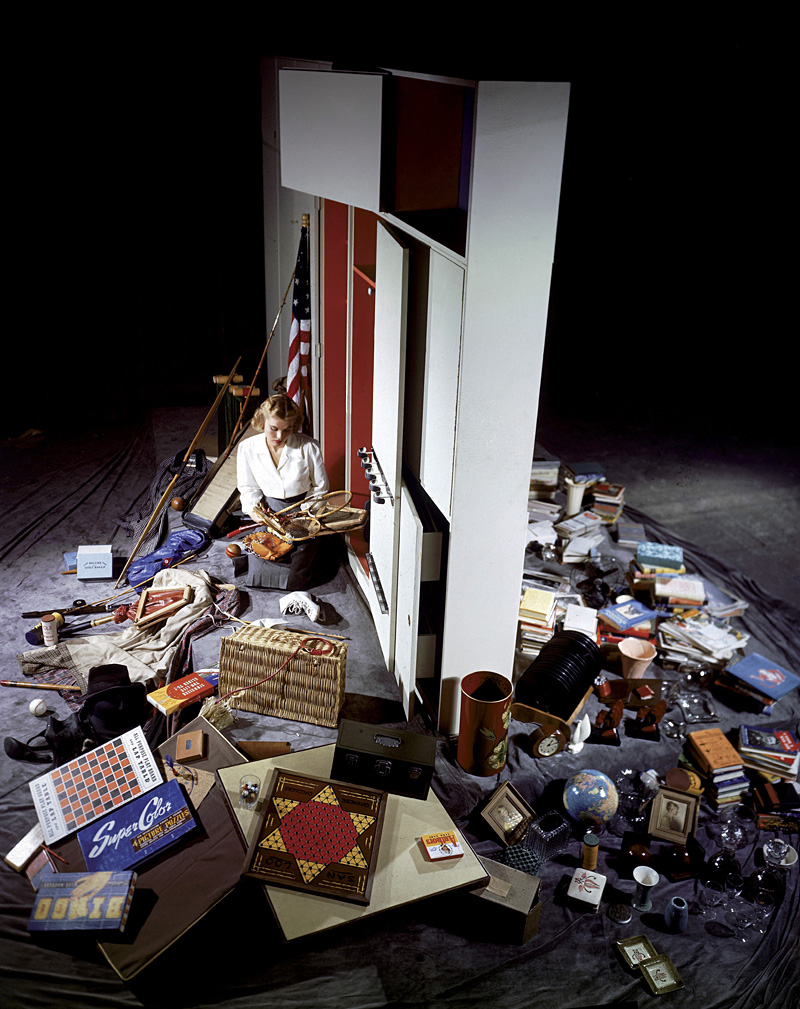Remember your very first day in an office? Was it dreary, terrifying, or exciting in a new grown-up’s “I’m actually wearing a tie/nylons to work!” kind of way? The answer may depend on when you entered the workforce. Today’s millennials—if they’re lucky enough to have a job at all—are accustomed to desks made of doors pitched on sawhorses, a tangle of network cables slung from the rafters. Yuppies from the glowing-green-cursor ’80s may recall the novelty of glass-walled conference rooms and buzzing fax machines. And for those pre-Boomers now mostly retired, BAM’s ongoing George Nelson show celebrates the furniture and design of what we now call mid-century modernism. Yes, it’s the Mad Men era, but it’s also the postwar moment when the realigned U.S. economy began to boom, corporations grew into multinational behemoths, and World War II technologies were newly applied to office chairs and filing cabinets. If you were there (and have a gold watch and pension to show for it), the exhibit will raise plenty of nostalgia. For those of us slaving away in cubicles today, with worthless 401(k)s and lucky to have our own staplers, it’s like a walk through the Hollywood sets used by Don Draper and company.
This traveling show is sponsored by Herman Miller, the furniture- and office-design firm that employed Charles Eames, Isamu Noguchi, and Eliot Noyes alongside Nelson (1908–1986). Eames, subject of a documentary soon to air on PBS, is today perhaps the best-known of the bunch; but as Herman Miller’s design director, it was Nelson who hired Eames and others who took advantage of the bent-wood and shaped-aluminum methods developed for military aircraft. All the capital and labor that had been tied up in the war effort was suddenly unleashed. But how to give form to America’s new industrial might? New skyscrapers were rising with open floor plans. Women (!) were entering the workforce, if only to peck on IBM Selectric typewriters. Office parks were rising in the old suburbs. It was a time of innovation, investment, and profound optimism—nothing like today.
But before Nelson’s tenure at Herman Miller (1946–64), he first gained national prominence for home design, co-creating the 1944 “Storagewall”— the grandfather of all IKEA storage systems. (A hilarious spread for Life magazine shows a housewife overwhelmed by the books, LPs, board games, fishing rods, and tennis rackets of a typical suburban home.) A decade later, Nelson wrote, “Possessions of all descriptions had multiplied, activities had broadened, and any number of luxury gadgets had become common household tools. Where to keep them?” He answered that question with a modular approach that became the template for his office designs: desks with tidy hidden compartments, flip-out typing stands, and finally the L-shaped desktop configuration so ubiquitous today.
Much of this Nelson exhibit is pure furniture porn for mid-century modernists. You can’t sit in any of the workstations or on the couches, but each piece taunts you like a priceless estate-sale find. (Somewhere in a Bellevue rambler, about to be sold by an 80-year-old widow, there’s a Marshmallow Sofa and set of Coconut Chairs . . . you can just feel it!) The office pieces are mostly scuffed and worn, with ink and cigarette stains. You can examine but not flip through old Herman Miller brochures and catalogs; each new line, like the Action Office 2, was like an updated iPhone for its day. At a time when we were putting men on the moon and the first bytes on silicon, the office also had to be smart and modern. Promotional videos and slide shows speak to this new ethos; one amusingly lauds the secretary who “needs decor, color, warmth, vitality.” (Wait, isn’t that one of Draper’s pickup lines?)
Many of Nelson’s famous numeral-less clocks—George Jetson meets Jim Flora—are on display, which may send you to allmodern.com and other sites to shop for the reissues. It’s worth remembering, however, that most items here are from Nelson’s design firm—including movie posters, corporate logos, and ads—not his individual hand. Like Herman Miller, he was a brand. And BAM’s presentation could be looser—why not have period music playing in the gallery (Sinatra, Davis, Jobim)? Why not serve highballs at special evening shows (cocktail attire required)? Still, unlike Pan Am and other echoes of JFK-era cool, it’s worth remembering that Nelson’s intent wasn’t entertainment but commerce. Good design made for good business. In which sense, his modern analogue isn’t a fictional character like Don Draper but a packaging perfectionist like Steve Jobs.








